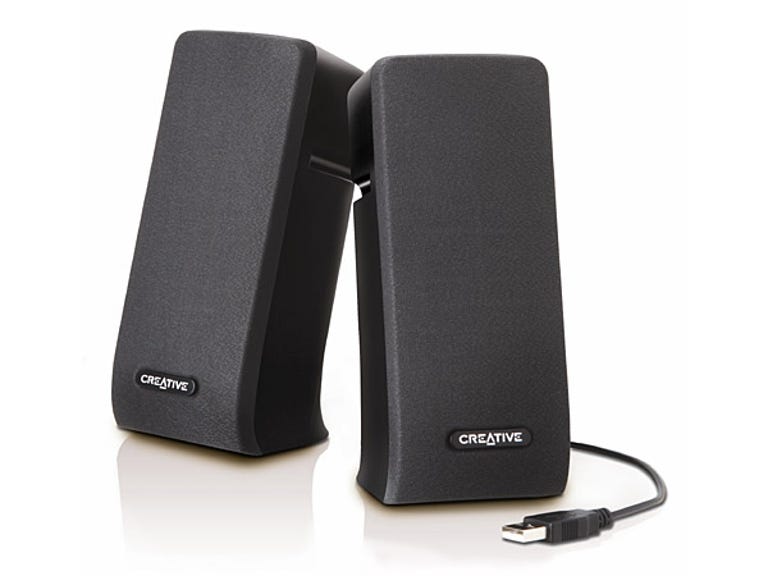 Why You Can Trust CNET
Why You Can Trust CNET Creative SBS A40 USB-powered speakers review: Creative SBS A40 USB-powered speakers
Offering reasonable sound, including tolerable bass levels at a very low price, the Creative SBS A40 speakers are a bargain.
Design and features
The Creative SBS A40 USB-powered speakers conform to conventions for these kinds of things. There are two small speaker cabinets (small, but perhaps a touch bigger than average), one passive and one active. The passive one — which weighs 215 grams alone — carries the left channel signal and is connected to the right speaker, which does most of the work.
The Good
The Bad
The Bottom Line
The right one has within it a stereo amplifier rated at a modest 0.8 watts per channel (RMS, says Creative, for Root Mean Square, but that's not a valid term for power). This has on its top a push button hard-wired power switch and a knurled thumb wheel that acts as an analog volume control.
The USB cable and the input signal cable also come from the right-hand speakers.
Creative doesn't mention the size of the speaker drivers used in these units, but does note that they are bass reflex loaded (there is a bass port at the back of each enclosure) and magnetically shielded. We doubt that with the demise of floppy discs and CRT monitors that this is not of much importance any more. The drivers are fronted by a cloth grille stretched over a sturdy plastic grate. This grille cannot be removed.
Set-up is simple, of course. Put the green plug into the headphone socket, the USB plug into the USB socket, and you're done. After you press the power switch, of course. We like hard-wired power switches because you can be confident that when switched off, the system is drawing no power at all from your notebook.
The speakers are tilted up very slightly so that they "fire" a little more directly towards your ears.
As usual with separate speakers, they're not the best for taking with you on your travels. Indeed, the review set had obviously been used before and it took us a while once we got them out of the box simply to untangle all the cables.
Performance
The price of this system is low: just AU$19.95. They'd have to sound pretty horrible to score badly at the price, and the fact is they actually sound quite reasonable.
The sound is coloured, no doubt about it, but not too badly. Most computer speakers tend to be a bit bright. This system was more mellow, with the treble falling away compared to the mid-range. That made them a more relaxing listen with music, but didn't detract at all from easy understanding of the spoken word.
They offered plenty of gain, easily exceeding the 70-decibel level — which some others had trouble reaching — on our test signal. As with some of the other more bass-capable speakers, they had a bit of trouble coping with loud playback of the Muse track, which features stacks of deep bass underlying a complex full-range signal. But when over-driven they seemed to lose their composure gradually as the volume was advanced, without any threatening rattling.
The measured performance had very low distortion components on the 1000 hertz sine wave at 70dB output. There was clear peak in the lower mid-range at 350 hertz, but reasonably smooth output from about 500 hertz to 4000, with that gradual downwards trend. The response fell away sharply at 15,000 hertz, in line with Creative's specification.
At the other end of the spectrum, below that 350 hertz peak, the response also fell away, but plateaued for a while so that there was still useful output down to about 125 hertz.
Conclusion
On some kind of ultimate scale, the sound of the Creative SBS A40 USB-powered speakers was kind of good enough for everyday use. But on a value-for-money scale, it was remarkable
.

